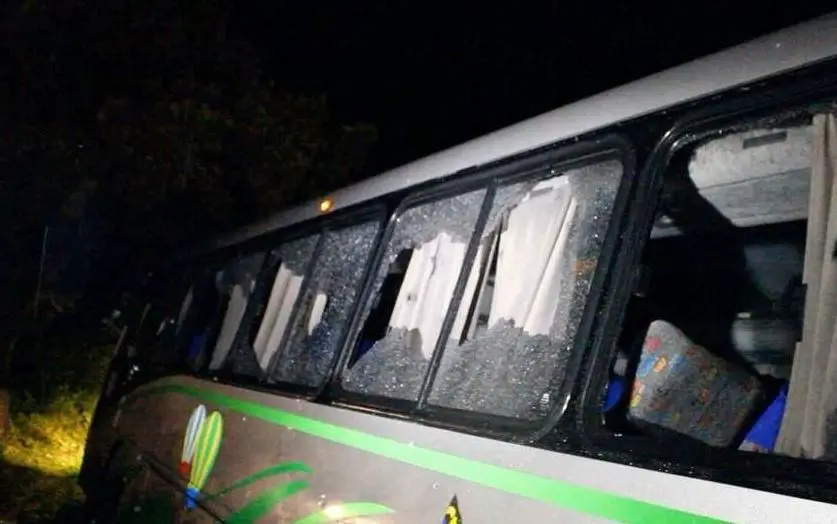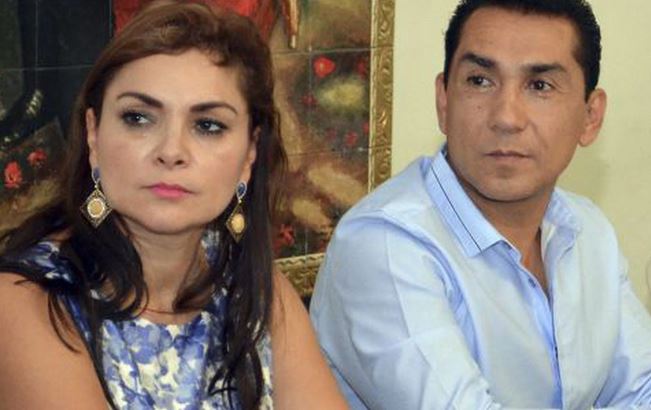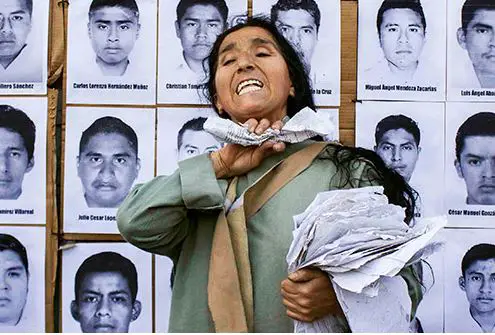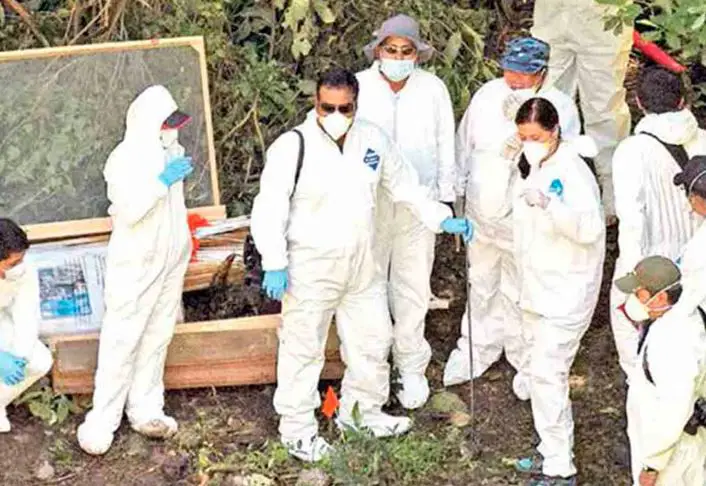On the night of September 26, 2014, in the north-central part of the Mexican state of Guerrero, 43 students disappeared without a trace. There are many theories as to what happened that night and a few alleged witnesses have since come forward providing information of events connected to this tragic occurrence. Many protests led by family members and empty promises made by Mexican politicians all the way up to the highest office in the land have led to nothing. Who were these students? What was the reason for their disappearance? What was their ultimate fate?
 The 43 students were young men at an all-male teacher training college in the town of Ayotzinapa, Guerrero. The small rural college has a history of leftist activism that has garnered scorn from some elements of the Mexican government. For example, two years before the disappearance of the 43, a group of students from the college shut down the highway leading from Cuernavaca to the Pacific coastal city of Acapulco, to protest a whole host of grievances against the government. Two students were killed in a clash with law enforcement during that protest. On the night of the disappearance – September 26, 2014 – the students were traveling to Mexico City to take part in protests and observances to mark the 1968 Tlatelolco Massacre where hundreds of students, activists and innocent bystanders were gunned down by local police. As they normally did, the Ayotzinapa students commandeered three buses to get to Mexico City on that tragic night. Anyone who has traveled throughout Mexico knows that most of the population gets around the country by bus instead of airplane and there are many different bus companies operating various routes between cities. The students had made it to the city of Iguala in northern Guerrero and stopped three buses from one of the independent bus companies convincing the bus drivers to take them to Mexico City. It’s important to note that the students allegedly did not take the buses by force; they asked the drivers if they would give them free transportation to Mexico City and the drivers agreed. The buses were barely on their way through the city of Iguala when the students encountered their first set of problems. The buses were stopped by the Iguala municipal police supposedly on a tip that they were hijacked, but this is not all that happened. Cell phone camera footage taken by one of the surviving students shows police officers opening fire on the buses without asking questions or making demands of the alleged hijackers. Some of the students screamed from the buses telling the shooters that they were unarmed, but the police continued firing. A few of the students lay dying with no emergency services coming to their aid. The police also mistakenly fired on a bus carrying a local soccer team, killing a team member, the driver, and an unsuspecting woman getting into a taxi who was hit in the head by a stray bullet. Hours went by, and another squad of armed men descended on the buses. Some witnesses claim that these were not local law enforcement. After the chaos ended and the firing of the second group stopped, local police officers showed up and took away the remaining students, who numbered 43. When dawn came, two students were found shot dead in the street and a third was found mutilated close to the scene of the bus incident. A total of 6 people were killed and 25 people injured in the events of that night.
The 43 students were young men at an all-male teacher training college in the town of Ayotzinapa, Guerrero. The small rural college has a history of leftist activism that has garnered scorn from some elements of the Mexican government. For example, two years before the disappearance of the 43, a group of students from the college shut down the highway leading from Cuernavaca to the Pacific coastal city of Acapulco, to protest a whole host of grievances against the government. Two students were killed in a clash with law enforcement during that protest. On the night of the disappearance – September 26, 2014 – the students were traveling to Mexico City to take part in protests and observances to mark the 1968 Tlatelolco Massacre where hundreds of students, activists and innocent bystanders were gunned down by local police. As they normally did, the Ayotzinapa students commandeered three buses to get to Mexico City on that tragic night. Anyone who has traveled throughout Mexico knows that most of the population gets around the country by bus instead of airplane and there are many different bus companies operating various routes between cities. The students had made it to the city of Iguala in northern Guerrero and stopped three buses from one of the independent bus companies convincing the bus drivers to take them to Mexico City. It’s important to note that the students allegedly did not take the buses by force; they asked the drivers if they would give them free transportation to Mexico City and the drivers agreed. The buses were barely on their way through the city of Iguala when the students encountered their first set of problems. The buses were stopped by the Iguala municipal police supposedly on a tip that they were hijacked, but this is not all that happened. Cell phone camera footage taken by one of the surviving students shows police officers opening fire on the buses without asking questions or making demands of the alleged hijackers. Some of the students screamed from the buses telling the shooters that they were unarmed, but the police continued firing. A few of the students lay dying with no emergency services coming to their aid. The police also mistakenly fired on a bus carrying a local soccer team, killing a team member, the driver, and an unsuspecting woman getting into a taxi who was hit in the head by a stray bullet. Hours went by, and another squad of armed men descended on the buses. Some witnesses claim that these were not local law enforcement. After the chaos ended and the firing of the second group stopped, local police officers showed up and took away the remaining students, who numbered 43. When dawn came, two students were found shot dead in the street and a third was found mutilated close to the scene of the bus incident. A total of 6 people were killed and 25 people injured in the events of that night.
 There are competing stories as to why the buses were fired upon in the first place. The first, the official story, is that the police were responding to a hijacking. Another story claims that the police were called in to attack the buses because they were transporting heroin, unknown to the students who commandeered them. Yet another story claimed that the mayor of Iguala, José Luis Albarca, ordered the attack on the buses because the day the students arrived in Iguala Albarca’s wife, María de los Angeles Pineda, was having a political rally and the mayor did not want the students to disrupt the rally. The mayor’s wife was running for mayor as her husband’s replacement, and she just so happened to have a brother who is a key figure in a local drug cartel called the Guerreros Unidos. Some believe that the second attack on the buses came from elements of this drug cartel sent to finish the job that the local police did not complete. Suspiciously, Mayor José Luis Albarca and his wife María de los Angeles Pineda, fled Iguala a few days after the incident.
There are competing stories as to why the buses were fired upon in the first place. The first, the official story, is that the police were responding to a hijacking. Another story claims that the police were called in to attack the buses because they were transporting heroin, unknown to the students who commandeered them. Yet another story claimed that the mayor of Iguala, José Luis Albarca, ordered the attack on the buses because the day the students arrived in Iguala Albarca’s wife, María de los Angeles Pineda, was having a political rally and the mayor did not want the students to disrupt the rally. The mayor’s wife was running for mayor as her husband’s replacement, and she just so happened to have a brother who is a key figure in a local drug cartel called the Guerreros Unidos. Some believe that the second attack on the buses came from elements of this drug cartel sent to finish the job that the local police did not complete. Suspiciously, Mayor José Luis Albarca and his wife María de los Angeles Pineda, fled Iguala a few days after the incident.
According to the official government account, and according to eyewitnesses at the scene, after the bus attack the remaining unharmed 43 students were whisked away by the local police. From the police station they were transported to somewhere out of town and handed over to members of the Guerreros Unidos, the local drug cartel with ties to the wife of the mayor of Iguala. These narcos were told that the students were members of a rival gang called Los Rojos. That being the case, the leaders of the cartel immediately decided to kill the students. Again, according to the official story, some students were put in a trash dumpster and were suffocated to death, and some were shot. This all took place 14 miles away from the city of Iguala near the town of Cocula. At a landfill outside of town, the bodies were supposedly thrown into a ditch and were burned in a fire. The fire was started with wood, old tires and gasoline and was allowed to burn for 14 hours. The gang threw dirt on the smoldering ashes and after everything cooled, they took the remains of the students and threw them into a river. This tidy official story was released by the Mexican government in January of 2015, about 4 months after the disappearance of the 43 Ayotzinapa students.
Initially, there were arrests of police officers involved in the bus attack, but parents of the students and others were left wondering what had happened to the 43 missing from the buses. With no official story from the government yet, parents along with hundreds of concerned individuals began searching for the students on their own in a coordinated effort to find them. On October 5, 2014, just nine days after the disappearance an interesting discovery was made by one of these citizens groups while searching the back country outside of Cocula. The group came across a mass grave full of charred human remains. The Mexican military took over the site and determined that the mass grave was more than 9 days old and identified 28 people who were not the missing students. The official government story was that these were people murdered in connection with local drug violence. The relatives of the missing 43 pressed on and kept looking for answers. One rumor going around, substantiated by alleged witnesses, claimed that the 43 young men were being detained at a local army barracks. When pressed for more information, the Mexican army refused to answer any questions in connection with this rumor and denied access to the military base to parents of the students, thus fueling more suspicions.
 Throughout October of 2014 protests raged throughout the state of Guerrero. On October 13, protestors marched on the state government offices in the capital of Chilpancingo. Initially, the protests were peaceful, but masked agitators showed up and looted and burned the government offices. Some believe that either the government itself or the cartels were responsible for the protest turning violent. The following week, two other protests erupted in the state capital, with 200 people storming the headquarters of the PRD, the political party in control of the state government. The protests eventually went to Mexico City with thousands of people participating. On October 29, 2014, the president of Mexico, Enrique Peña Nieto, met with the relatives of the missing 43 at Los Pinos, the presidential residence in Mexico City, to pledge his support in the investigation and to outline a plan of action. This was the day after the Office of the General Prosecutor of Guerrero arrested 22 Iguala police officers in connection with the kidnapping. All 22 officers were charged with and convicted of aggravated murder for the bus attack, but no one had yet been charged for the kidnapping of the students.
Throughout October of 2014 protests raged throughout the state of Guerrero. On October 13, protestors marched on the state government offices in the capital of Chilpancingo. Initially, the protests were peaceful, but masked agitators showed up and looted and burned the government offices. Some believe that either the government itself or the cartels were responsible for the protest turning violent. The following week, two other protests erupted in the state capital, with 200 people storming the headquarters of the PRD, the political party in control of the state government. The protests eventually went to Mexico City with thousands of people participating. On October 29, 2014, the president of Mexico, Enrique Peña Nieto, met with the relatives of the missing 43 at Los Pinos, the presidential residence in Mexico City, to pledge his support in the investigation and to outline a plan of action. This was the day after the Office of the General Prosecutor of Guerrero arrested 22 Iguala police officers in connection with the kidnapping. All 22 officers were charged with and convicted of aggravated murder for the bus attack, but no one had yet been charged for the kidnapping of the students.
So, were the students missing or dead? By early 2015 there were still no straight answers and elements of the official story did not add up. The relatives of the missing students called in a neutral party to help with the investigation, the Argentine Forensic Anthropology Team, known by its Spanish acronym EAAF. This team is a world-renowned group of analysts that has conducted forensic investigations in hot spots of global conflict such as El Salvador, the Congo, Bosnia and Colombia. The team analyzed the evidence recovered thus far and initiated their own investigation at the Cocula Dump, where the bodies of the students were supposedly burned. In its report released in early 2016, the Argentine team concluded that not only were the bodies not burned at the dump, but there never was a fire of the magnitude claimed at that location. This utterly discredited the official story released by government officials going all the way to the national level.
 There is a long list of political resignations and arrests connected with this case. The mayor of Iguala and his wife were eventually discovered hiding out in a Mexico City neighborhood. As of this recording they are still in prison serving sentences for money laundering and for conspiring with the cartels. Amid the flurry of arrests and resignations, what of the missing 43? Have any of them been found since that infamous night in 2014 either dead or alive?
There is a long list of political resignations and arrests connected with this case. The mayor of Iguala and his wife were eventually discovered hiding out in a Mexico City neighborhood. As of this recording they are still in prison serving sentences for money laundering and for conspiring with the cartels. Amid the flurry of arrests and resignations, what of the missing 43? Have any of them been found since that infamous night in 2014 either dead or alive?
Three of the students’ remains have been identified. Charred bone fragments found early on in the investigation were identified as belonging to 19-year-old Alexander Mora Venancio. The location of where Mora’s remains were found is disputed. Initially, it was claimed that the charred fragments came from the Cocula Dump where the bodies were supposedly burned, but the chain of evidence had been broken so badly that no one could be sure exactly where they were found. In 2019 the remains of a foot bone were found in a gully about a half mile from the trash dump and were identified as belonging to 19-year-old student Christian Alfonso Rodriguez Telumbre. In this same location investigators also found human remains that were identified in 2021 as belonging to 20-year-old student Jhosivani Guerrero de la Cruz. In December of 2018, the government of Andrés Manuel López Obrador announced the formation of a “Truth Commission” to investigate further the case of the missing students, but relatives are upset that the commission has not gone far enough and has not provided them with any real answers. To date, 40 of the students remain unaccounted for.
As with everything of this significance, various theories and much speculation have surrounded this case. As this event has not had closure for many years, people are apt to fill in the blanks as they always do. Hundreds if not thousands of people go missing in Mexico every year and end up never being seen again, with most of these instances chalked up to involvement in drug trafficking. Is there more to this story and did the students have a deeper connection to the cartels? Are they alive somewhere in Mexico working as forced labor for the cartels in the poppy and marijuana fields? Were they taken out of the country through a human trafficking network? Is there a more sinister explanation here involving connections to the occult? As much time has passed since this famous mass kidnapping, we may never have answers to our questions.
REFERENCES
Articles in Vice and the BBC online
